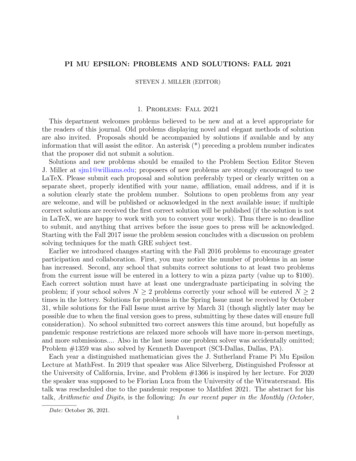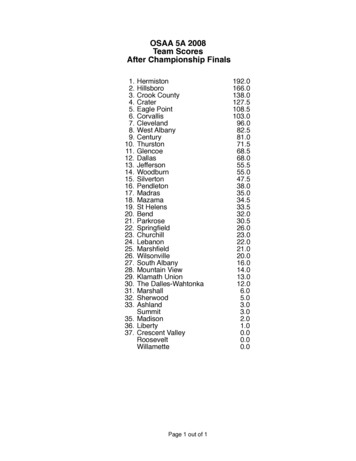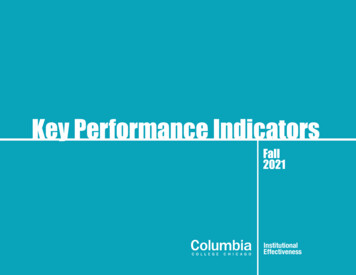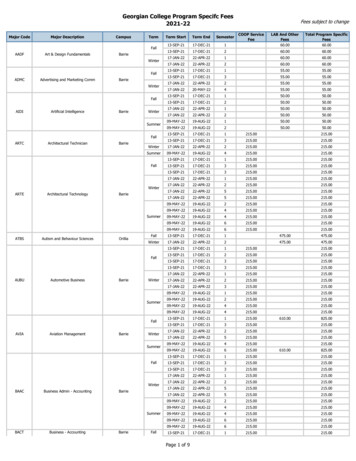
Transcription
PI MU EPSILON: PROBLEMS AND SOLUTIONS: FALL 2021STEVEN J. MILLER (EDITOR)1. Problems: Fall 2021This department welcomes problems believed to be new and at a level appropriate forthe readers of this journal. Old problems displaying novel and elegant methods of solutionare also invited. Proposals should be accompanied by solutions if available and by anyinformation that will assist the editor. An asterisk (*) preceding a problem number indicatesthat the proposer did not submit a solution.Solutions and new problems should be emailed to the Problem Section Editor StevenJ. Miller at sjm1@williams.edu; proposers of new problems are strongly encouraged to useLaTeX. Please submit each proposal and solution preferably typed or clearly written on aseparate sheet, properly identified with your name, affiliation, email address, and if it isa solution clearly state the problem number. Solutions to open problems from any yearare welcome, and will be published or acknowledged in the next available issue; if multiplecorrect solutions are received the first correct solution will be published (if the solution is notin LaTeX, we are happy to work with you to convert your work). Thus there is no deadlineto submit, and anything that arrives before the issue goes to press will be acknowledged.Starting with the Fall 2017 issue the problem session concludes with a discussion on problemsolving techniques for the math GRE subject test.Earlier we introduced changes starting with the Fall 2016 problems to encourage greaterparticipation and collaboration. First, you may notice the number of problems in an issuehas increased. Second, any school that submits correct solutions to at least two problemsfrom the current issue will be entered in a lottery to win a pizza party (value up to 100).Each correct solution must have at least one undergraduate participating in solving theproblem; if your school solves N 2 problems correctly your school will be entered N 2times in the lottery. Solutions for problems in the Spring Issue must be received by October31, while solutions for the Fall Issue must arrive by March 31 (though slightly later may bepossible due to when the final version goes to press, submitting by these dates will ensure fullconsideration). No school submitted two correct answers this time around, but hopefully aspandemic response restrictions are relaxed more schools will have more in-person meetings,and more submissions. Also in the last issue one problem solver was accidentally omitted;Problem #1359 was also solved by Kenneth Davenport (SCI-Dallas, Dallas, PA).Each year a distinguished mathematician gives the J. Sutherland Frame Pi Mu EpsilonLecture at MathFest. In 2019 that speaker was Alice Silverberg, Distinguished Professor atthe University of California, Irvine, and Problem #1366 is inspired by her lecture. For 2020the speaker was supposed to be Florian Luca from the University of the Witwatersrand. Histalk was rescheduled due to the pandemic response to Mathfest 2021. The abstract for histalk, Arithmetic and Digits, is the following: In our recent paper in the Monthly (October,Date: October 26, 2021.1
Figure 1. Pizza motivation; can you name the theorem that’s represented here?2019) with Pante Stănică, we looked at perfect squares which arise when concatenating twoconsecutive positive integers like 183184 4282 with the smaller number to the left, or98029801 99012 with the larger number to the left. My talk will present variations onthis topic with the aim of providing the audience with examples of numbers which are botharithmetically interesting (like perfect squares) while their digital representations obey someregular patterns. The examples will not be limited to perfect squares, but will also includeother old friends like Fibonacci numbers and palindromes. His talk is available online at ,and related to that is the following bonus problem:Let f (x) ax2 bx c be a polynomial with integer coefficients and positiveleading term. Find conditions on a, b, c such that f (x) x(x 1) has infinitely many positive integer solutions x. Here x(x 1) is the concatenation ofx with x 1 as in our paper. (Thus 20(21) 2021.)One final note: I would like to express my thanks to George Stoica for submitting all theproblems for this issue.#1377: Proposed by George Stoica, Saint John, New Brunswick, Canada. Consider adecreasing and positive sequence {a2k 1 }k 1 . Prove there exists another decreasing andpositive{a2k }k 1 such that the combined sequence {an }n 1 is decreasing and thePsequence series n 1 an converges to an irrational number.#1378: Proposed by George Stoica, Saint John, New Brunswick, Canada. Let A Mn (C),the set of n n complex matrices, be such that det(Ak In ) 1 for any positive integer k.Prove that An On , the n n zero matrix.#1379: Proposed by George Stoica, Saint John, New Brunswick, Canada. Let (xn )n be asequence of real numbers, uniformly distributed modulo 1 and non-decreasing. Prove thatthe sequence (xn / log n)n 2 is unbounded. Can one replace (log n)n 2 by another sequencethat approaches faster than log n?#1380: Proposed by George Stoica, Saint John, New Brunswick, Canada. It is very wellnXknown that, if limai exists, then lim an 0. Prove that the conclusion may be falsen i 1n 2
under the (weaker) hypothesis that limnXai exists. (Square brackets denote the integern i [n/2] 1part).#1381: Proposed by George Stoica, Saint John, New Brunswick, Canada. Is it true that Xxn 0 if xn 1 xn an for all n 1, with an & 0 andan ?n 1GRE Practice #8 Consider the polynomialf (x) 6x8 7x7 25x6 30x5 16x4 8x3 37x2 x 10.As the coefficients of f are relatively prime, by Gauss’ Lemma if we can write f (x) as aproduct of two polynomials with rational coefficients then we can write f as a product oftwo polynomials with integer coefficients. Which polynomial below divides f (x)?(a) x5 4x4 2x2 3 (b) x4 3x3 2x 4 (c) 2x5 4x3 3x2 4 (d) x5 4x3 2x 5(e) 2x3 4x2 x 6.2. Solutions#1371: Proposed by Harold Reiter (University of North Carolina Charlotte).A set of chess knights is called independent if none of them attack any of the others.(1)(2)(3)(4)How manyHow manyHow manyProve thatways can 6 independent knights be placed on an 4 4 chess board?ways can 8 independent knights be placed on an 4 4 chess board?ways can 7 independent knights be placed on an 4 4 chess board?nine knights cannot be arranged independently on a 4 4 chess board.Solved by Watson Houck, Barringer Academic Center.As the solution is long and detailed, it is posted here: ic html/pme/PMEknights sept4th.pdf.#1374: Proposed by Himadri Lal Das, Indian Institute of Technology Kharagpur, India.Let fn : [0, 1) N {0}, n N, be a family of functions, where fn (x) is the number ofnonzero terms up to n decimal places of x [0, 1). Letc 0.1010010001 . . .n (c)find a closed form expression for fn (c) and calculate lim f . Here N is the collection ofnn all positive integers.Solved by Henry Ricardo, Westchester Area Math Circle. Also solved by Brian D.Beasley, PresbyterianP College. k(k 1)/2We observe that c —that is, the digit 1 appears at the decimal placesk 1 10corresponding to triangular numbers. Therefore fn (c) counts the number of triangular numbers k(k 1)/2, k N, that are less than or equal to n: 1 1 8nk(k 1)2 n k k 2n 0 if and only if k .223
Since k must be an integer, we have fn (c) 1 1 8n2 ,where b·c denotes the floor function. Thus we have 1 1 8n 2fn (c) 1 1 8n .2 nn2 nSince 1 8n 2 1 1 8n1 lim lim 8 2,n n 22 n2 n the Squeeze Theorem yields fn (c)/ n 2 as n . 1 #1376: Proposed by Hongwei Chen, Christopher Newport University.ProveZ 1Z 1x ln(x) ln(y)1 2dxdy π G,24800 (1 x )(1 xy)Pk2where G k 0 ( 1) /(2k 1) is the Catalan constant. This problem is originated fromthe study of generalization of Euler sums, which has recently been an active research topic.For example, we haveZ 1 Xln xLi2 ( x)( 1)n 1 X( 1)kdx ,221 x2n(2k n 1)0n 1k 0where Li2 (x) is the Dilogarithm function defined by XxkLi2 (z) .k2k 1SinceZLi2 (x) 01x ln ydy,1 xywe have1Z 1Z 1ln xLi2 ( x)x ln(x) ln(y)dx dxdy.221 x000 (1 x )(1 xy)Solved by Seán M. Stewart, Bomaderry, NSW, Australia.Denote the integral whose value is to be proved by I. We begin by writing the integral asfollowsZ ZZ Z1 1 1 x log(x) log(y)1 1 1 x log(x) log(y)dx dy dx dy.I 2 0 0 (1 x2 )(1 xy)2 0 0 (1 x2 )(1 xy)ZBy symmetry found in the integrand an interchange between the two dummy variablesappearing in the right most double integral yieldsZ ZZ Z1 1 1 x log(x) log(y)1 1 1 y log(y) log(x)I dx dy dy dx,2 0 0 (1 x2 )(1 xy)2 0 0 (1 y 2 )(1 yx)4
orZ ZZ Z1 1 1 y log(x) log(y)1 1 1 x log(x) log(y)dx dy dx dy,I 2 0 0 (1 x2 )(1 xy)2 0 0 (1 y 2 )(1 xy)after the order of integration in the right most integral has been changed. Thus Z Z xlog(x) log(y)1 1 1ydx dyI 222 0 0 1 x1 y1 xyZ Z1 1 1 (x y)(1 xy) log(x) log(y)dx dy 2 0 0(1 x2 )(1 y 2 )(1 xy)Z Z1 1 1 (x y) log(x) log(y) dx dy2 0 0(1 x2 )(1 y 2 )Z ZZ Z1 1 1 x log(x) log(y)1 1 1 y log(x) log(y) dx dy dx dy2 0 0 (1 x2 )(1 y 2 )2 0 0 (1 x2 )(1 y 2 )Z ZZ Z1 1 1 x log(x) log(y)1 1 1 x log(y) log(x) dx dy dy dx,2 0 0 (1 x2 )(1 y 2 )2 0 0 (1 y 2 )(1 x2 )where in the last line we have exploited the symmetry found in the integrand. Changing theorder of integration in the right most integral yields Z 1 Z 1 Z 1Z 1x log(x) log(y)x log(x)log(y)I dx dy dx ·dy .(2.1)2221 x200 (1 x )(1 y )00 1 yEach of the integrals that have appeared can be readily found. For the first of theseZ 1Z 1Z 1X Xx log(x)kk 2k 1( 1)x2k 1 log(x) dx.( 1) xlog(x) dx dx 21 x000 k 0k 0Here the interchange made between the summation and integration can be justified usingthe dominated convergence theorem. Integrating by parts twice we findZ 1 x log(x)1 X ( 1)k1 X ( 1)kdx ,1 x24 k 0 (k 1)24 k 1 k 20where a reindexing of the sum of k 7 k 1 has been made. As XXX( 1)k 12( 1)k X 1 ,2222kkk(2k)k 1k 1k 1k 1we see that X( 1)kk 1 X 11X 11X 1π2 ,2 k 1 k 2 k 1 k 22 k 1 k 212k2giving1x log(x)π2 1π2dx · .1 x212 4480A similar thing can be done for the second of the integrals. Here we haveZ 1Z 1Z 1X Xlog(y)k 2kkdy ( 1) y log(y) dy ( 1)y 2k log(y) dy.20 1 y0 k 00k 0Z5
Here the interchange made between the summation and integration can again be justifiedusing the dominated convergence theorem. Integrating by parts twice yieldsZ 1 Xlog(y)( 1)kdy G.22(2k 1)0 1 yk 0Combining the results found for the two integrals into (2.1) yields 2 π1 2I · ( G) π G,4848as required to prove.GRE Practice #8 Consider the polynomialf (x) 6x8 7x7 25x6 30x5 16x4 8x3 37x2 x 10.As the coefficients of f are relatively prime, by Gauss’ Lemma if we can write f (x) as aproduct of two polynomials with rational coefficients then we can write f as a product oftwo polynomials with integer coefficients. Which polynomial below divides f (x)?(a) x5 4x4 2x2 3 (b) x4 3x3 2x 4 (c) 2x5 4x3 3x2 4 (d) x5 4x3 2x 5(e) 2x3 4x2 x 6.We could of course factor this. If we use the rational root test, we find that if p/q is a rootthen q 6 (the leading term) and p 10 (the constant term); if you remember something likethe test but not the exact statement you can often “find” it by looking at a special case; hereif we look at 3x 2 0 we find the root is p/q 2/3, and thus p 2 while q 3. Doing this, wefind the possibilities for rational roots are 1, 2, 5, 10, 1/2, 5/2, 1/3, 2/3, 5/3, 10/3, 1/6, 5/6. This is a long list! After work we find 1/2, 1, 2/3 are roots, and thusf (x) is divisible by (2x 1)(x 1)(3x 2). Doing the long division, we seef (x) (2x 1)(x 1)(3x 2) · (x5 4x3 2x 5),and thus the answer is (d).Would it be faster to just try the five possibilities and see which one works? Probably! Inthis case I would probably try (d) or (e) first, under the assumption that it is unlikely theywould have (a) work as that would cut down on the time.Of course, as the point of these problems is to show faster ways to find the answer, thereis a better approach. We do not need to factor f (x); we need to find which of the fivecandidates is a factor. We are thus told one and only one works. All we need to do is finda way to eliminate four of the five options. The simplest way is to specialize x. If we takex 0 we get f (x) 10, so whatever of the five choices is a factor, its specialization mustdivide. The five options, at x 0, are 3, -4, 4, 5 and 6; of these only 5 divides 10, and thusthe answer is (d)!We might have been unlucky and had two or more candidates successfully divide whenx 0. If that had happened, try specializing to x 1. If we still have more than oneoption in play, try 2.Email address: sjm1@williams.edu6
Professor of Mathematics, Department of Mathematics and Statistics, Williams College,Williamstown, MA 012677
GRE Practice #8 Consider the polynomial f(x) 6x8 57x7 25x6 30x 16x4 8x3 37x2 x 10: As the coe cients of f are relatively prime, by Gauss' Lemma if we can write f(x) as a product of two polynomials with rational coe cients then we can write f as a product of two polynomials with integer coe cients. Which polynomial below divides f(x)?











